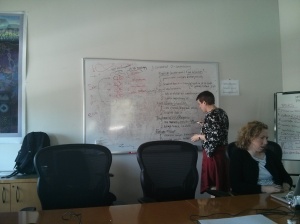NESCent meeting on anthropogenic sensory stimuli & evolution (noise, light, ecology, people & citizen science)
In citizen science, you always learn new things, and one of the aspects of this area that I like most is the cross-over between different areas of science. By learning about citizen science projects, you also learn about current research activities in Astronomy, Ecology, Conservation, Environmental Science and many other areas.
Some occasions, however, provide an opportunity to explore things in a deeper and more concentrated way. The catalyst meeting in the US National Evolutionary Synthesis Center (NESCent) in Durham, NC, on anthropogenic sensory stimuli as drivers of evolution was such event. The meeting was organised by Caren Cooper (Cornell Lab of Ornithology) Jesse Barber (Boise State University) and Clint Francis (California Polytechnic State University) and they assembled an outstanding group of researchers for it, with diverse backgrounds including ecology, astronomy, geography, social science and citizen science. So ‘anthropogenic sensory stimuli as drivers of evolution‘ translates to 4 and a bit busy days of concentrated work on research questions that link sound and noise; light and darkness; animals and wildlife; and citizen science. In particular, the meeting explored the scientific issues of light and noise pollution on humans and other animals (with some attention to birds and insects in particular because of expertise of participants) on the one hand, and thinking in what ways citizen science activities can be included to understand and manage these issues on the other.
In many academic meetings, most of the time is dedicated to tell other people ‘what have I done’ and even if the aim is to develop something from the meeting (say, a book), still most of the time is dedicated to the pattern: presentation, Q&A, presentation, Q&A … with discussion and further discoveries during breaks, dinners or over a drink. Workshops where new directions are explored, are commonly restricted to a day or two, which doesn’t give enough time to explore issues in depth, especially in situations were the participants are not familiar to one another. By the time you get to know people from different area of research, the meeting is over! Only rarely there are longer meetings of 4 or 5 days – so far in my academic career, I attended one – a European Science Foundation exploratory workshop on the internet of things and sustainability almost 3 years ago. The NEScent catalyst meeting belongs to the latter group of long and detailed workshops.
The workshop brought together people who are researching how to understand and model night light or noise at global and local scales, as well as people with experience in citizen science, and experts in ecology, evolution and biodiversity with an interest in the impact of light and noise. To start the discussion, we have used the framework of ‘programme logic model‘ and considered the range of long term impacts of academic and citizen science research, and what sort of research questions can be addressed. The set of questions range from considering social impacts, perceptions, health – with some potential causal chains emerging.
The synthesis work explored how to integrate different areas of research – from concepts to methodologies to data. 
After setting up the general model, we set out to work in groups – and at this stage the group was split between those who focus on social science and citizen science projects, and those that are more focused on evolutionary biology and ecology. By focusing on the development of specific models and aiming to start seeing how concepts in each area match, it was possible to identify gaps. It was especially fascinating to see how people shared their knowledge and provided to each other short introductions about their research areas. For example, I have learned a lot about the concepts of coupled human-nature systems and how it is linked/subsumed in social-ecological systems. An example for the synthesis that can happen in such a workshop is the expansion of the later concept to “social, ecological and evolutionary systems”. Another group explored what is possible to discover from data that is already available and used in different projects.
The workshop also provided hands-on opportunity to explore how to measure darkness, using the ‘loss of night‘ app, as well as ‘Globe at night‘ and having the researchers that are leading these projects, Connie Walker and Chris Kyba, provided more understanding of the activities and the way the information is collected.
The outcomes of the workshop will be academic papers and research projects that will emerge in the near future – and a network of researchers with much better understanding of each other area.
